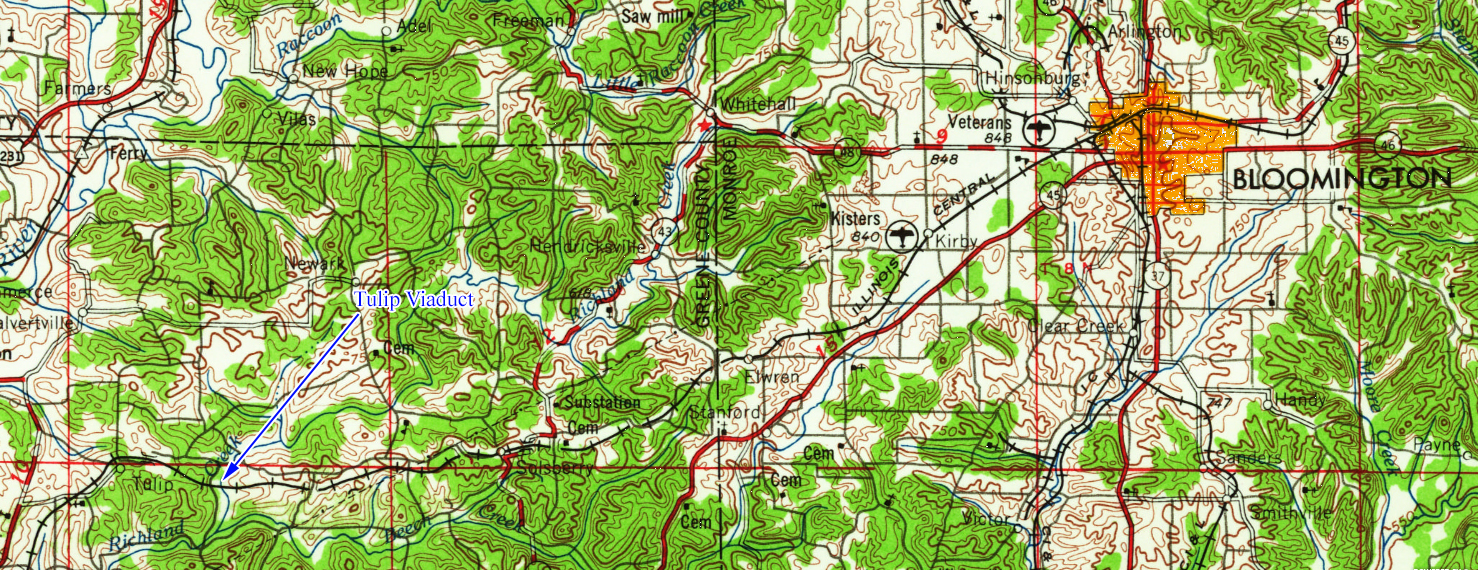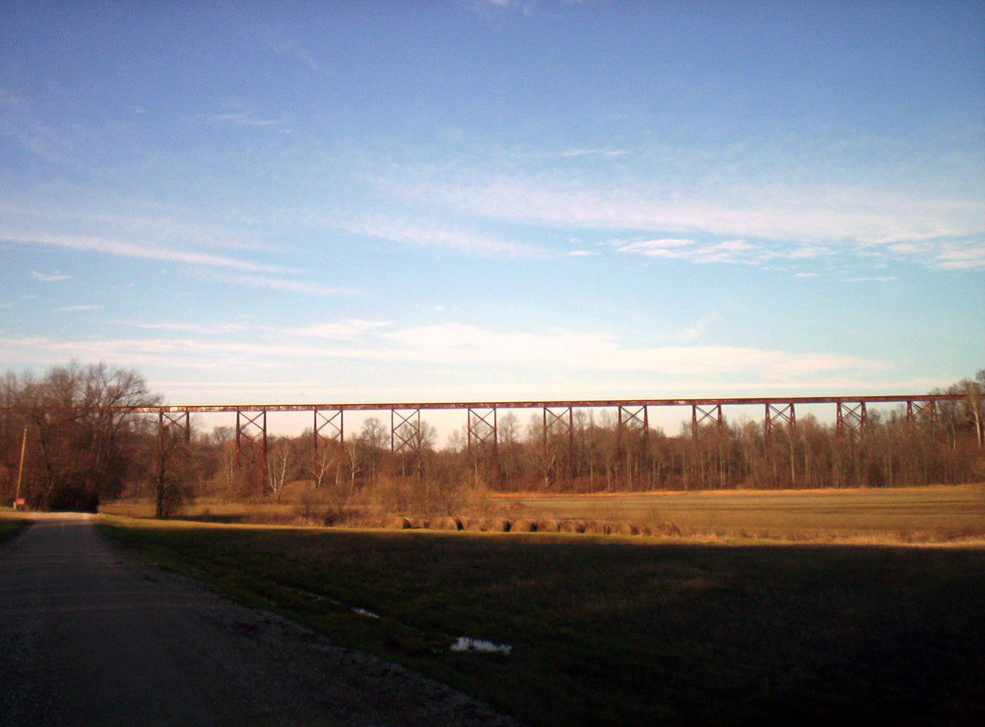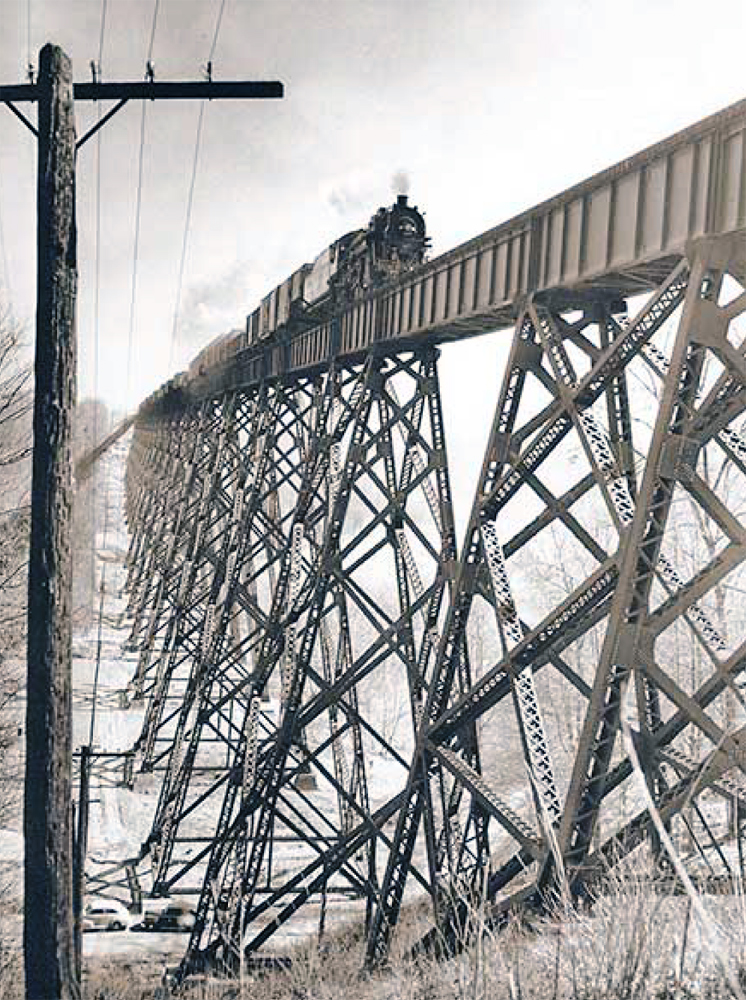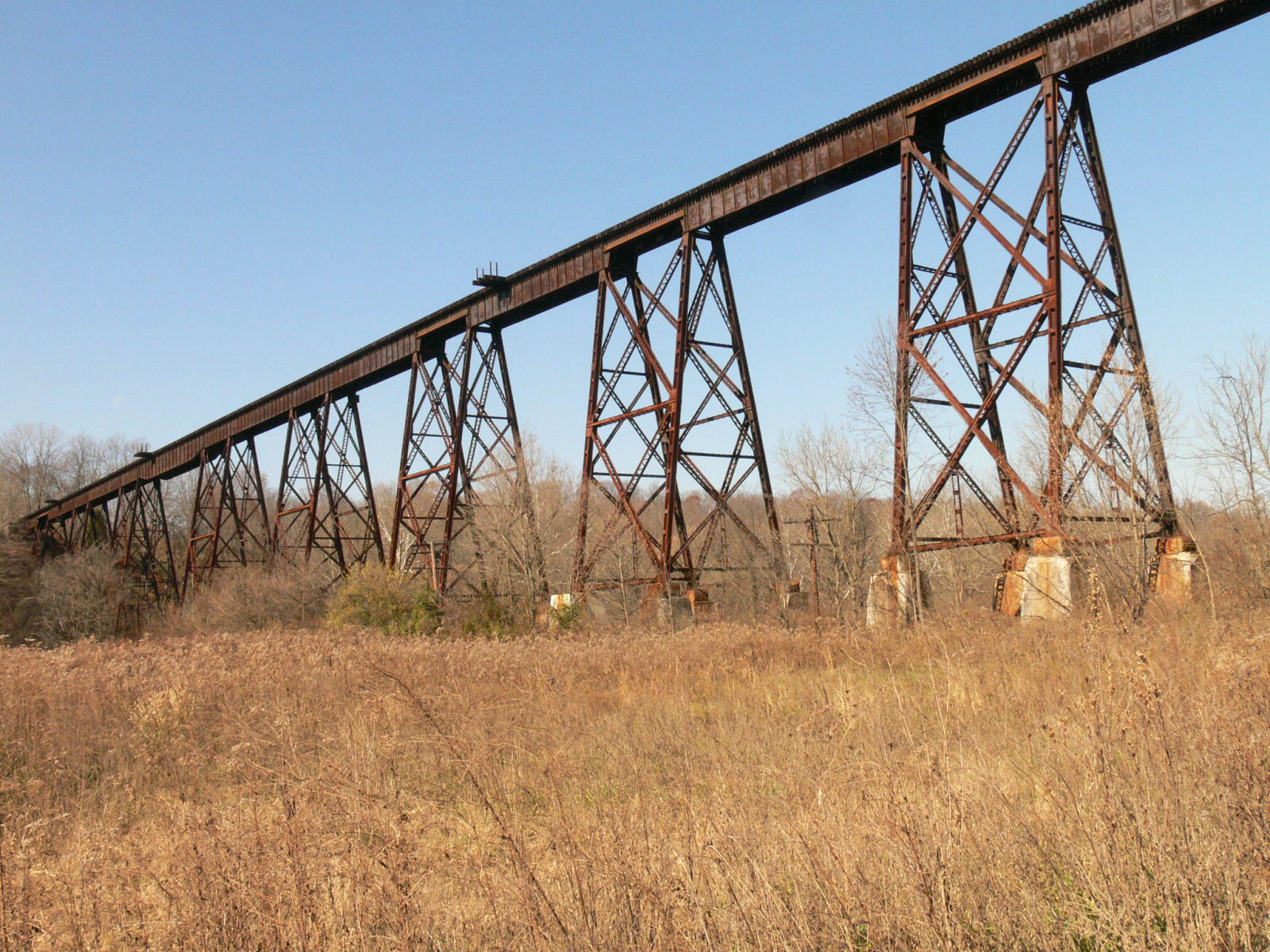Tulip Viaduct Bridge (Indiana): Trains, Map, History
Last revised: August 24, 2024
By: Adam Burns
Illinois Central's Tulip Viaduct is a hidden engineering marvel located among the rolling hills and farmland of southwestern Indiana, about 25 miles west of Bloomington.
The bridge was constructed for the Indiana Southern Railway during the first decade of the 20th century but very soon was acquired by the growing Illinois Central. The structure is an impressive sight from the ground as it spans an open valley and stands more than a half-football field in the air.
The line where the viaduct is located would constitute the IC's furthest reach eastward as it connected to the important city of Indianapolis. During the mid-1980s as the IC was shedding large sections of its system the route to Indy was sold to regional Indiana Rail Road, and the viaduct remains in use under that company today.
The bridge's future appears quite secure as it acts as a key component of the Class II's 250-mile network. At present, the railroad's system forms a rough "X" from Indianapolis to eastern Illinois.
It also operates a north-south segment that reaches Terre Haute and Chicago. The viaduct can be along the eastern arm of this "X" in Greene County.
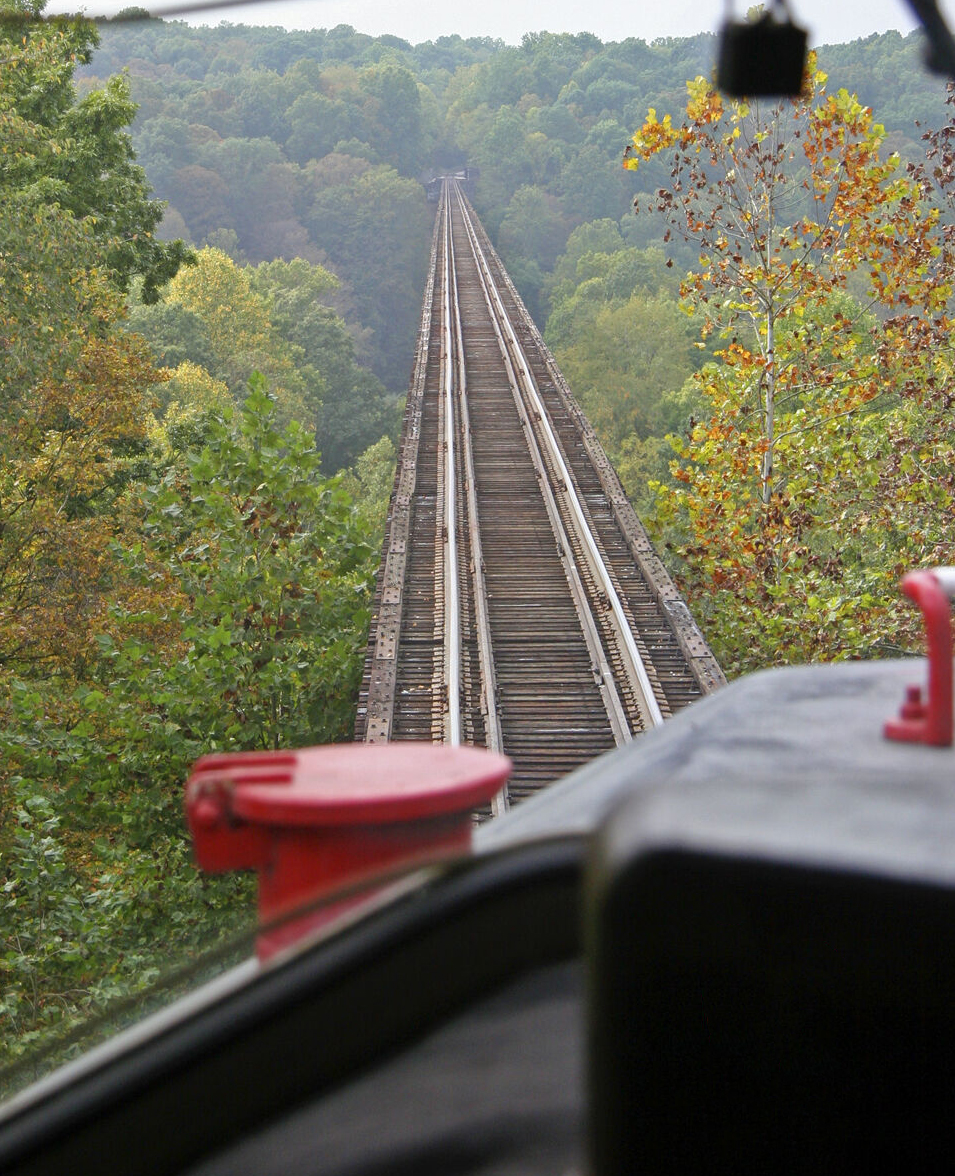 Taken from the conductor's side of the cab of an Indiana Rail Road SD9043MAC, the locomotive is crossing Tulip Viaduct.
Taken from the conductor's side of the cab of an Indiana Rail Road SD9043MAC, the locomotive is crossing Tulip Viaduct.History
The Tulip Viaduct, also known as the Greene County Viaduct or Richland Creek Viaduct, is a marvel of early twentieth-century railroad engineering.
The bridge itself is an archetypal example of a deck girder bridge. These types of bridges utilize a series of sizable horizontal beams, often steel or iron, lined in parallel from one end to the other to support the deck of the bridge from below.
To understand the history of the the viaduct a little background on the route that it was built for is important. The earliest railroad to construct a line east of Effingham, Illinois (where a connection with the IC was established) was the Cincinnati, Effingham & Quincy.
This system completed a narrow-gauge corridor of roughly 54.3 miles to Palestine along the Wabash River and the Indiana border. This railroad was later renamed as the Indiana & Illinois Southern (I&IS) in 1883, constructed a bridge across the Wabash reaching Switz City by 1886, and converted to standard-gauge operation in 1887.
During 1899 the Indianapolis Southern Railroad (IS) was incorporated by local Indianapolis businessmen to connect with the I&IS and offer a new western transportation artery for the city. About this time the Illinois Central became interested in both railroads as a means of reaching Indianapolis.
Map
Construction
The IC kept its distance from the IS project but it is said the growing railroad financed much of it. Construction of the IS began a few years later in 1903 heading roughly west from Indianapolis.
The Illinois Central commissioned the construction of the viaduct to facilitate the transport of coal and freight trains. Thanks to its unique design, the bridge was able to handle the substantial weights of the locomotives common during its heyday.
The viaduct served as a crucial link in the network of railways that stretched across the Midwest, marking a significant milestone in American railroad history.
To speed up the process in completing the railroad many fills were temporarily bypassed and instead wooden trestles were used, giving the line the nickname as the "Hi & Dry Branch." These were later fortified and made more permanent by filling in the bridges (a process that was actually not that uncommon).
The design phase lasted several months, culminating in a final blueprint of a structure that was both grand in magnitude and structurally sound. The engineers took the challenging terrain into account, ensuring that the viaduct would stand strong despite the varying elevations along its span.
Construction began in earnest in 1905 and required approximately a year and a half of work. The combination of expert engineering, skilled labor, and the industrious spirit of early twentieth century America resulted in an extraordinary combination of form, functionality, and sheer visual presence.
Work began during the summer of 1905 when crews began clearing the property for the many pier foundations required to span the nearly half-mile long valley.
Over the next year crews, predominantly Italian immigrant labor, poured the concrete foundations (handled by the Collier Bridge Company), which was completed on May 12, 1906.
Work slowly continued on the project and it is said locals would often congregate in the fields next to and adjacent from the bridge, having picnics and get-togethers as the crews worked.
By August of that year all of the materials had arrived on-site to begin actually erecting the steel, which officially commenced on September 8th.
Dimensions
In terms of sheer magnitude, the Tulip Viaduct is immense. The bridge boasts a total length of 2,307 feet (approximately 0.43 miles) and sits 77 feet above the picturesque valley below, making it one of the longest single-work girder bridges in the world.
The bridge was assembled by the Strobel Steel Construction Company from south to north (or west to east) and featured 38 steel columns.
The viaduct featured 2,856 tons of steel in its construction, all provided by the American Bridge Company and cost a staggering $246,504 (or roughly $20 million today). The structure towered over the Richland Creek valley and was 157 feet above the ground at its highest point.
When the steel fabrication of the project was completed on November 6, 1906, the bridge was the largest of its kind in the world, an impressive feat considering it was more or less along a branch line.
Officially, the viaduct opened to rail traffic on December 21st of that year as a few additional months were required to finish laying ties, rails, and other minor work.
The Indianapolis Southern was short-lived as an independent company; the Indiana & Illinois Southern and IS were soon merged and then taken over the Illinois Central in 1911 giving the road access to Indianapolis.
Running west from Indianapolis Union Station the IC's line is exactly 177.6 miles to Effingham (according to the company's 1969 timetable) where it reconnects with the Chicago main line.
Over the succeeding decades, the viaduct served as a key artery in the Illinois Central's network, facilitating the efficient transport of goods and raw materials.
The bridge's impressive load-bearing capacity was crucial to the scale and pace of logistical operations becoming synonymous with the booming industrial period of the early twentieth century.
Bridge Number
The viaduct, listed as bridge X76-6 by the railroad, was named for the small nearby hamlet of Tulip which was located at milepost 77.5 (due west).
Interestingly, despite this route serving Indianapolis and having popular runs like the City Of New Orleans, Panama Limited, City Of Miami, and numerous others the IC never operated any named trains to the city and ended all passenger service over the corridor by 1948.
The bridge continued to carry freight for many decades to follow, even through the merger with the Gulf, Mobile & Ohio in 1972. Unfortunately, the GM&O union saw two road's serving much of the same territory and in an attempt to improve its financial situation the company shed thousands of miles of trackage in the 1980s, which included the line to Indianapolis.
In 1986 it was sold to the new Indiana Rail Road, today a 500+ mile
prospering regional that continues to operate the route, and viaduct, as
far west as Newton (153.4 miles).
Legacy
Despite the sweeping changes in the railroad industry over the years, the Tulip Viaduct has remained a constant. Today, it stands as a lasting monument to the determination, ingenuity, and foresight of its creators.
A testament to the endurance of the bridge is its designation as an Indiana Historic Civil Engineering Landmark by the American Society of Civil Engineers. This prestigious award has cemented the Tulip Viaduct's place as a treasured piece of the state's railroad history.
One of the fascinating aspects of the Tulip Viaduct is its resonance with locals and tourists alike. It continues to draw legions of history enthusiasts, photographers, and railroad aficionados who marvel at its monumental stature and historical worth.
The popularity of the viaduct extends to cultural representations as well. Several documentaries and short films have been produced about the Tulip Viaduct that bring its captivating history, architecture, and social impact to a broader audience.
Indiana Rail Road
In terms of conservation, the Indiana Rail Road has played a pivotal role in preserving the viaduct's integrity. Routine inspections and necessary repairs are made to keep the bridge functioning and safe for ongoing traffic.
Apart from the functional aspect, the IRR has undertaken initiatives to ensure the viaduct's structural integrity is preserved. Steps are taken to prevent corrosion, strengthen foundational aspects, and overall extend the lifespan of this impressive structure.
A significant element of the Tulip Viaduct’s enduring presence lies in reminders of a bygone era. Boarding a train that traverses the viaduct is akin to stepping back in time, presenting a direct, tactile connection with America's industrial past.
The viaduct's historical significance extends well beyond being merely a relic of the past. As a symbol of the ingenuity and progress that characterized the turn of the century, it provides insight into the evolution of rail transportation in the United States.
Through the years, the viaduct has seen countless locomotives and rail cars travel its length. The deck echoes the resounding hum of history, a historical dialogue between the past and the present set against the backdrop of Indiana's picturesque landscape.
Beside its sturdy steel skeleton lies the quiet, rural beauty of Greene County. It's a tranquil setting, where the old world grace of the Tulip Viaduct stands as a stark contrast against ever-changing seasons, a testament to the bridge's resilience through time and change.
The Tulip Viaduct's legacy is not just in steel, concrete, and rail ties. It is woven into the historical fabric of Indiana and American railroad development. It is an icon of industrial fortitude, a testament to engineering prowess and an enduring symbol of the transformative impact of rail travel on the American landscape.
Recent Articles
-
Oregon Railroad Museums: A Complete Guide
Apr 25, 25 03:11 PM
With its rich tapestry of scenic landscapes and profound historical significance, Oregon possesses several railroad museums that offer insights into the state’s transportation heritage. -
North Carolina Railroad Museums: A Complete Guide
Apr 25, 25 02:56 PM
Today, several museums in North Caorlina preserve its illustrious past, offering visitors a glimpse into the world of railroads with artifacts, model trains, and historic locomotives. -
New Jersey Railroad Museums: A Complete Guide
Apr 25, 25 11:48 AM
New Jersey offers a fascinating glimpse into its railroad legacy through its well-preserved museums found throughout the state.
